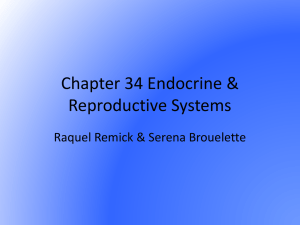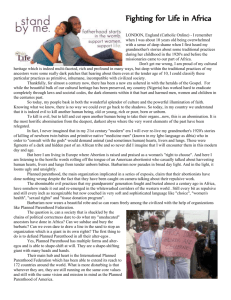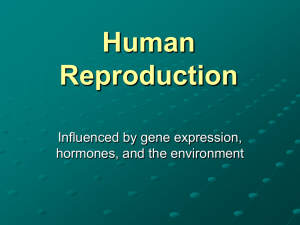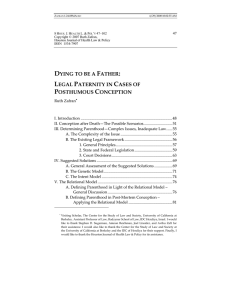Redefining Legal Parenthood in the Age Genomics and Assisted
advertisement
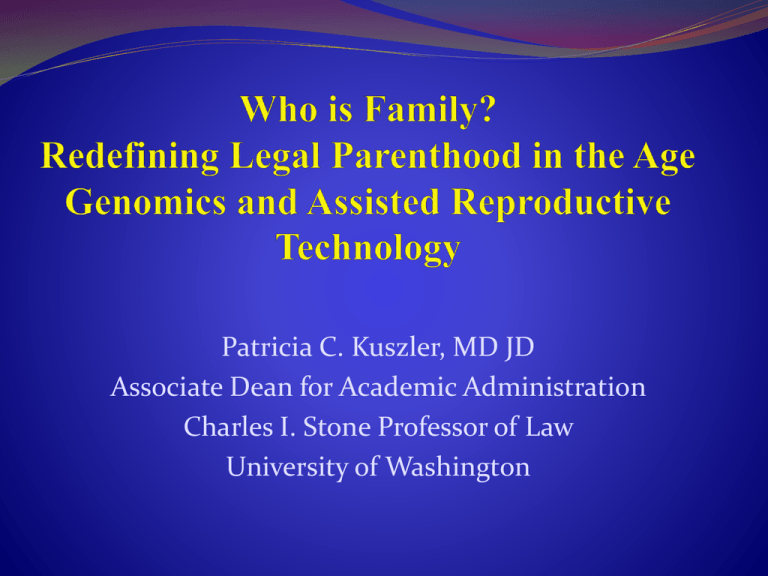
Patricia C. Kuszler, MD JD Associate Dean for Academic Administration Charles I. Stone Professor of Law University of Washington Overview The Science of Parenthood Assisted Reproductive Technologies (ART) Genomics and Genetic Testing What do ART and Genetic testing offer to prospective parents? To society? The Traditional Legal Construct of Parenthood Changing Family Norms in the wake of scientific advances Redefining Legal Parenthood in Response to Social Change Assisted Reproductive Technologies Sperm Donation Sperm are donated, although the service associated with the donation may be compensated Donation may be anonymous (sperm bank) or not anonymous Once donated, sperm banked until use in: Artificial Insemination In-vitro Fertilization Design Capacity Sperm banks typically maintain a “profile” of donor, including physical characteristics, health education, racial and ethnic background 3 Assisted Reproductive Technologies Egg Donation Like sperm, eggs are donated, although the service is compensated Egg harvesting requires considerably more service than sperm donation Like sperm, eggs are marketed with respect to traits Once donated Requires GIFT, ZIFT or In-vitro Eggs do not store well long-term 4 Assisted Reproductive Technologies Embryos Most commonly created in-vitro Insemination may be enhanced using ICSI Once created, can be frozen Can be tested for genetic disease, PGD 5 Assisted Reproductive Technologies Embryos May even be treated…. Have utility outside of the reproductive context 6 Assisted Reproductive Technologies In-vitro fertilization Has become the most common technique outpacing the earlier GIFT and ZIFT procedures Procedure Live birth rate per embryo transfer cycle IVF 31.0% ICSI 28.6% GIFT 24.5% ZIFT 29.2% Success rate varies – 20%-30% for each try Expensive often >$25,000/attempt + charges for PGD – another several thousand $ Used in cases of infertility; when couples seek preimplantation genetic testing; when a surrogate mother is used… 7 Prenatal Testing Ultrasound – began in the 1960s… Amniocentesis ↑ Maternal age Risk of genetic chromosomal or morphologic abnormality Chorionic Villus Sampling -- may be done earlier, but more risk 8 Prenatal Testing Maternal Serum testing for alpha-fetoprotein (AFP) Metabolic indicator for neural tube disorders, anencephaly, and Down syndrome Maternal Serum Fetal Cell Recovery – Non-invasive prenatal diagnosis Allows for the retrieval of shed fetal cells which are then referred for genetic testing – Full realm of genetic testing is possible 9 What does ART and genomics offer prospective parents? Opens the door to parenthood For the infertile For single parents For non-traditional parents Opportunity for early diagnosis of medical and genetic problems – and sometimes for early treatment 10 What does ART and genomics offer prospective parents? Opportunity to avoid pregnancy which will result in birth of baby with medical problems For some this allow them to sidestep abortion decision Opportunity to optimize traits of child Positive eugenics? Opportunity to prepare to care for a child with a disorder Is knowledge power? Is aiming for perfection a just and ethical goal? 11 What does ART and genomics offer prospective parents? The Downside… Uncertainty and Confusion Attachment difficulty The ‘Tentative” Pregnancy Devaluation of disabled or less than “perfect” kids Both within the family and society High cost and debt – economic crippling in quest for “better” child 12 What does ART and genomics offer society? Opportunity to address and avoid disease and disability Thus decreasing societal costs Help decrease the incidence of genetic diseases i.e. Tay-Sachs disease Further understanding of how technology may improve individual and population health 13 What does ART and genomics offer society? The Downside… Potential revival of negative eugenics – devaluation of the disabled or less “perfect” Increasing disparities and social injustice Dehumanizing the miracle of birth… 14 ART, Genomics and Family Law Legal Confusion! Who are the Parents? Genetic parents: contributors of DNA Sperm, Egg, and potentially cytoplasm of another Egg Gestational Mother – not necessarily genetically related Intended parents – at least 1, often 2, sometimes more….can theoretically be 6 or more! Performing parents – who acts as parent and fulfills role for the child? 15 What is Legal Parenthood? Classically Legal Parenthood determined using the Unitary Family standard Children born within a marriage have as their “legal” parents the married couple Presumed genetic bond Michael H v. Gerald D., 91 U.S. 110 (1989) Validated the “Unitary Family” definition Typically this “Unitary Family” approach is also found in civil codes around the world…. Genetics: the Holy Grail in Establishing Parenthood? Should Genetic connection be the determinant of parenthood? What about sperm donors who don’t wish to be legal parents, but merely donated sperm? What about egg donor who merely donated eggs? Sperm donor siblings? Donor sibling registry? Sperm and egg donor family trees? Robert B. v. Susan B., 135 Cal. Rptr. 2d 685 (6th Dist. 2003) Single woman seeks to become mother using anonymous sperm; inadvertantly given sperm of man seeking become father with his wife; he asserts parental rights over child born to single woman Pregnancy and Parenthood: the Gestational/Surrogate Mother Sometimes the surrogate mom is the gestational mom, sometimes not… Women serve as gestational mothers to assist infertile couples or prospective parents Fulfill dreams of parenthood for couples or non- traditional families. unable to have child Celebrated case of Baby M., 537 A. 2d 1227 (N.J. 1988): surrogate mom is also genetic mom and refuses to relinquish child after birth Surrogate contracts not recognized in many jurisdictions Concern of exploitation of women – baby factories Intended Parenthood: Does intent matter? In re Marriage of Buzzanca, 72 Cal. Rptr. 2d 280 (Cal. Ct. App. 1998) Couple decide to have child using assisted reproductive technologies (donor gametes, surrogate mother) but before child is born, couple divorces. Husband of couple refuses to support child. Neither egg donor nor gestational mom lay claim to the child. Who are the legal parents with duty to support child? In re Nicholas H., 120 Cal. Rptr. 2d 146 (2002) Man functions as father to child his former live in girlfriend leaves behind; years pass; biological parents completely abandon child, but child is loved and cared for by this Man, who functions as parent. Can he be recognized as a legal parent? In re Parentage of L.B. 155 Wn.2d 679 Lesbian couple have child, with one providing egg and gestation, and friend providing sperm; partner cares for the child functioning as parent. After several years, lesbian couple separate. Does the partner have any parental rights? Parenthood in the Context of Modern Family Structures Single parents Gay/Lesbian Parents “Elderly” parents Posthumous parents Prisoners “Saviour” Children Summary Science is taking parenthood further away from the “unitary” family model towards a “collaborative reproduction” model Society is creating an every increasing universe of potential parents and models of parenthood, including an ever increasing number of single parents and families not adhering to unitary family approach Genetics matters, but legal trend is towards recognition of intent and demonstrated performance as a parent equally pivotal in determining parenthood




